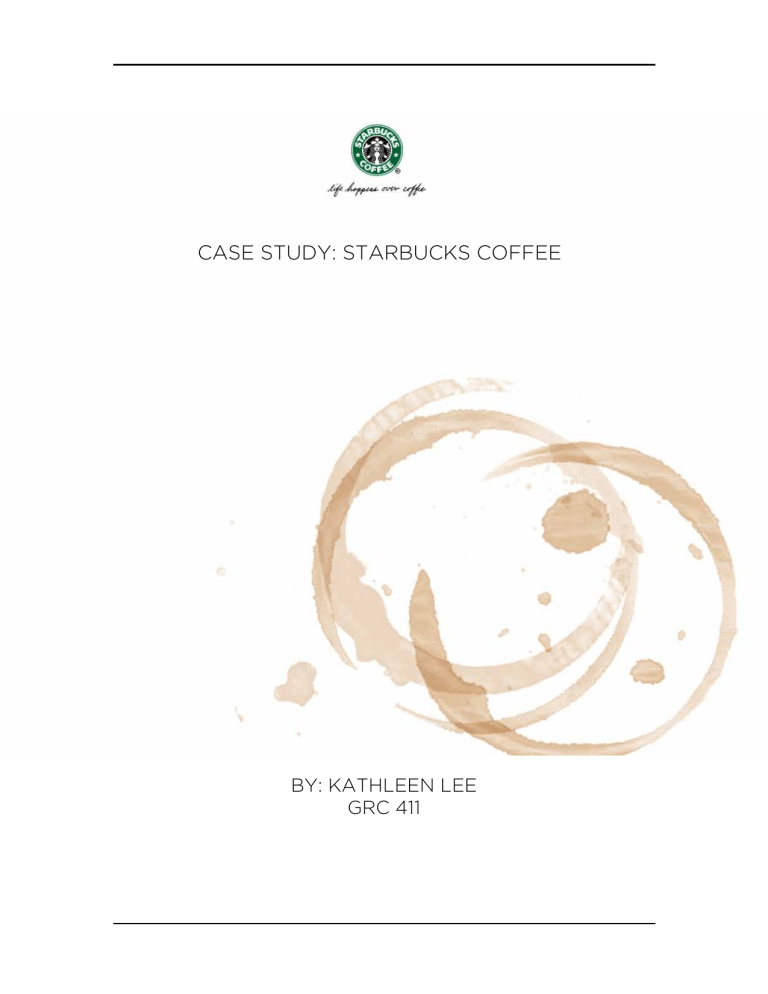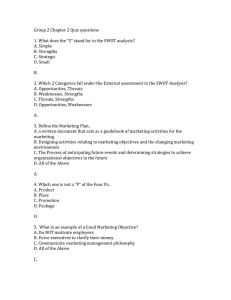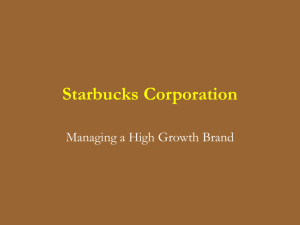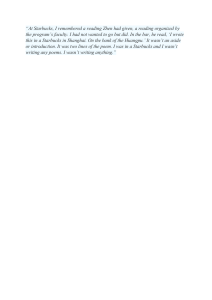
CASE STUDY: STARBUCKS COFFEE BY: KATHLEEN LEE GRC 411 CASE STUDY: STARBUCKS Brief History: The first Starbucks location opened in 1971. The name is inspired by Moby Dick’s first mate. This name and the mermaid logo were inspired by the love of the sea, from Starbucks original location in Seattle Washington in the heart of Pike Place Market. Starting as a single shop specializing in high quality coffee and brewing products the company grew to be the largest roaster in Washington with multiple locations until the early 80’s. In 1981, current CEO Howard Schultz, recognized a great opportunity and began working with the founder Jerry Baldwin. After a trip to Italy to find new products, Schultz realized an opportunity to bring the café community environment he found in Italy to the United states and the Starbuck’s brand we know today began to take form. Selling espresso by the cup was the first test. Schultz left Baldwin to open his own Italian coffee house Il Giornale which found outrageous success and in 1987 when Starbucks decided to sell the original 6 locations, Schultz raised the money with investors and purchased the company and fused them with his Italian bistro locations. The company experienced rapid growth going public in 1992, and growing tenfold by 1997, with locations around the United States, Japan and Singapore. Starbucks also began expanding its brand. According to George Garza in his article The history of Starbucks the following product lines were added: • Offering Starbucks coffee on United Airlines flights. • Selling premium teas through Starbucks’ own Tazo Tea Company. • Using the Internet to offer people the option to purchase Starbucks coffee online. • Distributing whole bean and ground coffee to supermarkets. • Producing premium coffee ice cream with Dreyer’s. • Selling CDs in Starbucks retail stores. Starbucks uses minimal advertising and has grown on word of mouth and brand recognition. According to Garza by 2004 Starbucks had reached 1,344 locations. (Garza) KATHLEEN LEE 1 CASE STUDY: STARBUCKS Updated history and Current Status Today, according to the Starbucks website, they have 16,706 stores (as of Dec. 27, 2009) in 50 countries. In 2009 they made strives socially as they opened the Farmer Support Center in Kigali, Rwanda and became the world’s largest buyer of Fair Trade CertifiedTM coffee. Their mission statement from the company profile is as follows: “Our mission is to inspire and nurture the human spirit – one person, one cup, and one neighborhood at a time.” Their core competencies can be defined as high quality coffee and products at accessible locations and affordable prices, provided a community to share in the coffee drinking experience, and variety of choices. The also value ethics and good business practices and are a leader being voted one of 2010’s most ethical businesses by Ethisphere magazine for the 4th year running. (“Starbucks”) Starbucks is facing its own struggles however as it saw sales start slipping before other companies did in the recent recession. According to Melissa Allison in her article Starbucks has a new growth strategy — more revenue with lower costs, Starbucks has closed 900 stores and eliminated 34,000 jobs. Starbucks new strategy is to refocus on some of the areas that decrease risk and up front investment. This includes expanding foreign stores, with aid of partnerships that share risk and costs, selling VIA instant coffee and other products in retail and convenience stores, and reinvigorating the Seattle’s Best Brand coffee. A statement from CFO Troy Alstead this March paints this picture: “We clearly hit a wall and didn’t do very well in the 2007/2008 time period. From here forward, when we grow Via, Seattle’s Best Coffee and consumer products, there’s less investment for each dollar of revenue.” KATHLEEN LEE 2 CASE STUDY: STARBUCKS This new strategy has inspired some optimistic feedback. Morningstar investment research firm has increased estimate of Starbucks shares from $4 a share to $24 after the statement of revamping the brand. Morningstar analyst had this to say R.J. Hottovy.: “I’m surprised it wasn’t ramped up in earlier years. Product innovations and international expansion not only make the business potentially more profitable, but defend them against competition.” International partnerships increase challenges but also create new ideas in new markets that can then be translated back to US markets. (Allison) Starbucks Lifecycle Introduction Growth Maturity Decline Starbucks in a mature stage of its lifescycle. It was founded over 20 years ago and it has experienced rapid growth in the last 2 decades. However within the last few years its growth has slowed and has even had to close locations. They are now focusing efforts on previous endeavors and international expansion. KATHLEEN LEE 3 CASE STUDY: STARBUCKS Value Chain Product Development Bean and ingredient Selection Product Distribution Storefront Take-home products The above is the value chain for Starbucks. The upstream portion of the value chain shows the product development from adding teas and international influences, to the research that took place to develop the VIA instant coffee line. They also search the globe for Fair Trade suppliers of high quality beans. These products are then distributed to corporate storefronts, franchise locations, airport terminals, grocery stores and more, and finally offer ground coffee and gift cards to take home. New Value Chain Product Development International Development Bean and ingredient Selection Product Distribution Online Storefront customization Storefront Mobile Apps Take-home products The above is a new value chain with international development added upstream to allow for international markets to develop new products that better suit there cultures that could potential add value to the US market as well such as the Green Tea Latte developed in Japan’s Starbucks. Added downstream is Online Storefront customization, that would allow you to create a profile online, order online, create new drinks etc. Also added is a mobile app that could locate starbucks locations, put in drink orders etc. KATHLEEN LEE 4 CASE STUDY: STARBUCKS Above is the Boston Matrix. It shows the cash cows as the regular Starbucks line of Coffee’s, Latte’s and Frappacinos found at nearly every location. These are stable products that account for the bulk of sales. A potential star is the International locations, which hold less financial risk and open doors for innovation and stability. Question marks are the recently added VIA instant coffee to be expanding to grocery stores and convenient stores. Current products like this such as the dog, pre-bottle frappacinos account for a tiny fraction of sales. Another question mark is the oft forgotten sub-brand Seattle’s Best. The company will be revamping this brand and it’s future is unknown. The following is Porter’s Generic Competitive strategy. Shown is Starbucks as a whole in the differentiation strategy as they provide a high quality coffee and unique experience in the convenience of a large volume of locations, which separates them from their competition. VIA, the new instant coffee line is straddling differentiation and low cost- leadership. While it will be a low cost and convenient alternative to Starbucks regular coffee, it is still unique from other products in the market. The in-store gifts and brewing utensils are in the focused differentia- KATHLEEN LEE 5 CASE STUDY: STARBUCKS tion category as they cater to the coffee lover, and are unique items found only in the Starbucks stores. Competetive Advantage Lower Cost Differentiation Starbucks Differentiation Cost Leadership VIA Cost Focus In-Store brewing products/gifts Focused Differentiation Below are the financial ratios from the income statement and balance sheets for Starbucks: 2009 2008 2007 Current 1.29 0.8 0.79 Acid Debt to Equity Gross Profit Net Margin 0.86 0.83 56% 0.19 0.49 1.28 20% 0.15 0.47 1.34 24% 0.3 The ratios show that assets vs. liabilities has increased which is promising after the risky pursuit of expanding to 30,000 has since been abandoned. The acid ratio also reflects this. Debt to equity has decreased which also shows stability. Gross profit has shown a large increase which is very good in a mature company. Their net margin in 2009 was very promising and is nearly a sustainable competitive advantage. KATHLEEN LEE 6 CASE STUDY: STARBUCKS SWOT Analysis Internal Factor Analysis Summary (IFAS) Internal Strategic forces Weight Rating Weighted Score Strengths S1- Brand Identity S2- Quality S3- Variety S4- Locations S5- Convenience S6- Store Ambiance S7- Ethics 20% 10% 10% 10% 20% 5% 5% 4 3 3 5 4 3 3 .8 .3 .3 .5 .8 .15 .15 W1- Overexposure W2- Too many products W3- Risky investment in more locations 10% 5% 5% 4 4 4 .025 .0125 .0125 TOTAL SCORES 1.00 Weaknesses 3.05 Comments S1- the company consistently maintains its brand, even without heavy marketing. S2- They search for quality beans worldwide. S3- They offer drink variety and customization. S4- locations are everywhere as one of the company’s main goals. S5- with new products live VIA, drive thru windows, instore locations convenience is important. S6- ambiance was a foundation of the starbucks brand and continues in its locations. S7- by using fair trade ingredients they are a leader in ethics. W1- Starbucks goal to have 30,000 locations stalled in the recent recessions. By becoming overexposed they risk losing the unique quality they were founded on. W2- By constantly adding products, some products have lost value, Seattle’s Best for example, and they are risky endeavors. W3 expanding locations in the US, is a high risk and costly investment in comparison to international expansion. External Factor Analysis Summary (EFAS) External Strategic forces Strengths- Opportunities Weight Rating Weighted Score O1- Customization O2- International Markets O3- On-the-Go Lifestyle O6- Partnerships 10% 15% 20% 10% 4 5 5 3 .4 .75 1 .3 KATHLEEN LEE 7 Comments O1- Starbucks introduced a completely custom frappacino in Canada. O2- Increasing efforts internationally, to increase stability. O3- VIA instant coffee and other products to be in groceries and convenience stores. O3 Partnering with more locations including NYSE. CASE STUDY: STARBUCKS Weaknesses- Threats T1- Direct Competition T2- Cheaper Alternatives T3- Recession 15% 15% 15% TOTAL SCORES 1.00 Strategic Factors S1- Brand Identity S5- Convenience W1- Overexposure O1- Customization O2- International Markets O3- On-the-Go Lifestyle T1- Direct Competition T2- Cheaper Alternatives Weight 20% 20% 5% 10% 15% 15% 5% 10% Total Score 1.00 3 2 4 .45 .3 .6 3.8 Rating 5 4 3 3 4 4 2 2 Weighted Score 1 .8 .15 .3 .6 .6 .1 .2 3.9 T1- Direct competition from Peets and Coffee Bean increasing. Lack of marketing T2- Cheaper alternatives from McDonalds and Dunkin Donuts T3- Recession has affected customers willingness to spend, greater risks in investment S S S I I I I L L L L Comments Brand Identity is extremely important to the company and is a long term factor for the company. Convenience is also one of the foundations that the company grew on and will continue to maintain their advantage. International Markets offer lower risk investment and innovation opportunities. Cheaper Alternatives like McDonalds threaten the convenience factor. Strategic Factor Analysis Summary (SFAS) The strategic factors summary shows that the most important factors overall received a score of 3.9 which is above average. This is positive for the company. They are responding well to their strength, weaknesses, opportunities and threats. After some recent re purposing it is clear that the company is focusing on its core competencies but has room to improve. KATHLEEN LEE 8 CASE STUDY: STARBUCKS Analysis of Key Issues facing the firm The key issues facing this firm was its attempts at massive expansion and creating new value innovation. The need to expand could cause the company to become over exposed and risk its ability to change. New players in the field such as McDonalds pose a new potential threat of competition, though it is unclear if they share the same market. Above are Porters 6 Forces and their level of threat to Starbucks. The bargaining power of suppliers is high because of the natural resources needed to create their ingredients and Starbucks believes in finding fair-trade and high quality beans, often from other countries These specifications limit the number of suppliers. The threat of new entrants is medium in that the coffee market is changing. The need for ambiance and a place to share is losing edge to the on-the-go alternatives, and should a new entrant come along with a different business model there is room for threat. However Starbucks is the household name. Industry competitors is on the rise because of McDonalds creating the McCafe line. Peets has increased presence as well. Threat of KATHLEEN LEE 9 CASE STUDY: STARBUCKS substitutes is low, because coffee is always going to be a desired drink and pastime of choice. Alternative Action There are alternative actions Starbucks can take to secure its competitive advantage it has upheld for so long. Below is the current value curve for Starbucks and its most relevant competitors Peets, and the McCafe Line. McDonalds shows a similar curve but lower in all levels. The one item that truly separates the two is the reputation Starbucks has in the coffee industry unlike McDonalds. The rest is similar, which shows a threat to Starbucks becoming part of a red ocean. Peets has an opposing curve, which could be a threat but their lack of volume, and brand recognition limits them from competition. My suggestions for the Four Action frame work would be to create more customization by allowing users to create new flavors and drinks above and beyond the options they have now. This would incorporate with the other creation of online user experience. Users could go on to the KATHLEEN LEE 10 CASE STUDY: STARBUCKS online Starbucks interface and have complete control to create their own drink, order online, find the nearest Starbucks and receive directions. Users could post their favorite drink combination and others could vote on it. Also involved in user experience could be mobile apps, putting in drink orders, finder etc. to enhance the Starbucks brand in the new digital era and to create a blue ocean for the coffee experience. KATHLEEN LEE 11 CASE STUDY: STARBUCKS Conclusion Overall Starbucks has maintained a competitive advantage since creating its original blue ocean of bringing quality, bistro-style coffee choices to the masses. In order to stay current it will need to focus on its core competencies and avoid spreading themselves to thin. To avoid competitors such as McDonalds and other coffee chains, they will need to create new value innovation by enhancing the customer experience by investing in online content and interactivity. Rather than creating more new products, I think their strength lies in their brand and by enhancing the connection to their loyal customers, they will separate themselves from McDonalds and others. SMJERNICE ZA IZRADU ZADATKA: 1. Definirajte misiju i svrhu poslovanja. 2. Analizirajte situaciju Starbucks-a. 3. Definirajte marketinške ciljeve. 4. Oblikujte marketinške strategije (imate budžet od 100.000kn) KATHLEEN LEE 12 CASE STUDY: STARBUCKS WORKS CITED Garza, George. “The history of Starbucks.” Catalogs.com. Catalogs.com, n.d. Web. 7 Jun 2010. <http://www.catalogs.com/info/food/the-history-of-starbucks.html>. “Our Heritage.” Starbucks. Starbucks, 2010. Web. 7 Jun 2010. <http://www.starbucks.com/ about-us/our-heritage>. Allison, Michelle. “Starbucks has a new growth strategy — more revenue with lower costs.” Seattle Times. Seattle Times, 15 May 2010. Web. 7 Jun 2010. <http://se attletimes.nwsource.com/html/businesstechnology/2011861321_star bucksstrategy16.html>. KATHLEEN LEE 13




